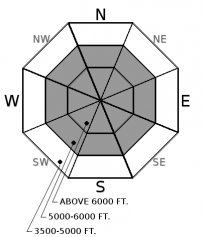| Wednesday | Wednesday Night | Thursday | |
|---|---|---|---|
| Cloud Cover: | Mostly/partly cloudy with light snow showers. | Light snow showers. | Cooler with light snow showers. |
| Temperatures: | 25-34 deg. F. | 10-20 deg. F. | 21-30 deg. F. |
| Wind Direction: | west | northwest | northeast-northwest |
| Wind Speed: | 6-7 | 4-5 | 4-5 |
| Snowfall: | 2-3 in. | 1-2 in. | 1-2 in. |
| Snow Line: |
Swan Range
Flathead Range and Glacier National Park
How to read the forecast
Heavy snow fall formed thin, reactive storm slabs late yesterday. Continued snow in the southern ranges this morning will thicken these slabs. The new storm snow will need a bit of time to settle and strengthen. The avalanche danger is CONSIDERABLE above 6000 feet. Human triggered avalanches are likely. Watch for obvious signs of instability like cracking and collapsing. The danger is MODERATE at mid elevations and LOW below 5000 feet. See advisory for Whitefish Range Here.

3. Considerable
?
Above 6500 ft.
2. Moderate
?
5000-6500 ft.
1. Low
?
3500-5000 ft.
- 1. Low
- 2. Moderate
- 3. Considerable
- 4. High
- 5. Extreme
-
Type ?
-
Aspect/Elevation ?

-
Likelihood ?CertainVery LikelyLikelyPossible
 Unlikely
Unlikely -
Size ?HistoricVery LargeLargeSmall

Since Monday up to a foot of new snow fell across the area. Yesterday, the heavy snow fall formed thin, but reactive storm slabs. With SNOTEL sites not reporting this morning there is uncertainty in the duration of the continued snowfall overnight. Expect slightly thicker, but still reactive storm slabs today. Look for obvious signs of instability in the new snow like cracking and collapsing.
We have not observed or been informed of any avalanches occurring on the January 19th crust or any other persistent weak layer in almost two weeks. However, in some places stability tests are still showing reactive results around the January 19 crust and, in isolated locations, the depth hoar at the base of the snowpack is reactive as well. Even though these layers have not produced any avalanches lately, it is still important to be aware that in some locations in the advisory area there is a poor snowpack structure with buried weak layers that may still be reactive. Because these weak layers do not always present obvious signs of instability, digging into the snowpack is the best way to determine their location and reactivity. Also you are more likely to find and/or trigger one of these weak layers in steep rocky terrain that typically has a more shallow snowpack.
* SNOTEL sites stopped reporting at 1400 yesterday. Weather data for the past 24 hours is based on Remote Weather Stations.
Tuesday: Erich and Adam were in the Skiumah/Rescue Drainages in the Flathead Range where they found about 40 cm of snow on top of the Feb. 10 crust. In stability tests fractures occurred within the new snow that did not propagate. On their descent they easily triggered thin (3-6 inch) storm slabs on steep slopes. Skiers on Skookoleel Ridge in the southern Whitefish Range found lingering instability within recent storm snow. They were also able to affect deep weak layers (110cm from the surface) using hard force in stability tests.
Monday: Guy and Jenny were in Doris Creek in the Swan Range. They found about 20 inches of snow above the most recent rain crust. In a snow pit at 6300 feet on an east aspect they had fractures within the most recent storm snow but no propagation. They did not observe any recent avalanche activity. BNSF Avalanche Safety was out in John F Stevens Canyon in southern Glacier Park. They observed no avalanche activity, no wind-loading, and no propagation in a snowpit at 6400 feet on a south aspect.
Sunday: Zachtern was in Rescue Creek in the Flathead Range. He noticed some minor cracking in the latest storm snow but did not observe any slab avalanches. In a snow pit at 6300 feet on NE aspect he found about 16 inches of snow above the Feb 10 crust. No propagation occurred in his stability test.
See below for all observations this season.
SNOTEL sites stopped reporting at 1400 yesterday so there is uncertainty in weather data from the past 24 hours. Yesterday we picked up 3-5 inches of new snow. Currently, temperatures at Remote Weather Stations above 6000 feet range from 19-22º F, with west and southwest winds at 3-5 mph with gusts from 5-15 mph. Today should see slightly cooler temperatures with continued snow showers and west winds at 5-10 mph.
| 0600 temperature: | 19-22* deg. F. |
| Max. temperature in the last 24 hours: | 27-33* deg. F. |
| Average wind direction during the last 24 hours: | SW |
| Average wind speed during the last 24 hours: | 5-10 mph |
| Maximum wind gust in the last 24 hours: | 15-24 mph |
| New snowfall in the last 24 hours: | 3-4* inches |
| Total snow depth: | 84-89* inches |
This advisory applies only to backcountry areas outside established ski area boundaries. This advisory describes general avalanche conditions and local variations always occur. This advisory expires at midnight on the posted day unless otherwise noted. The information in this advisory is provided by the USDA Forest Service who is solely responsible for its content.
















